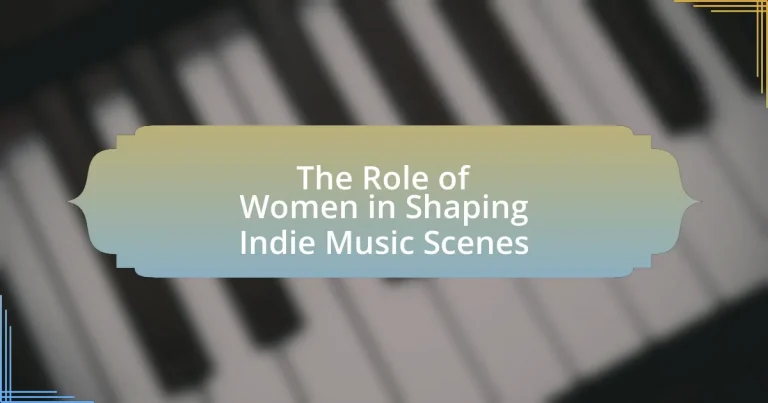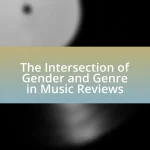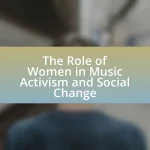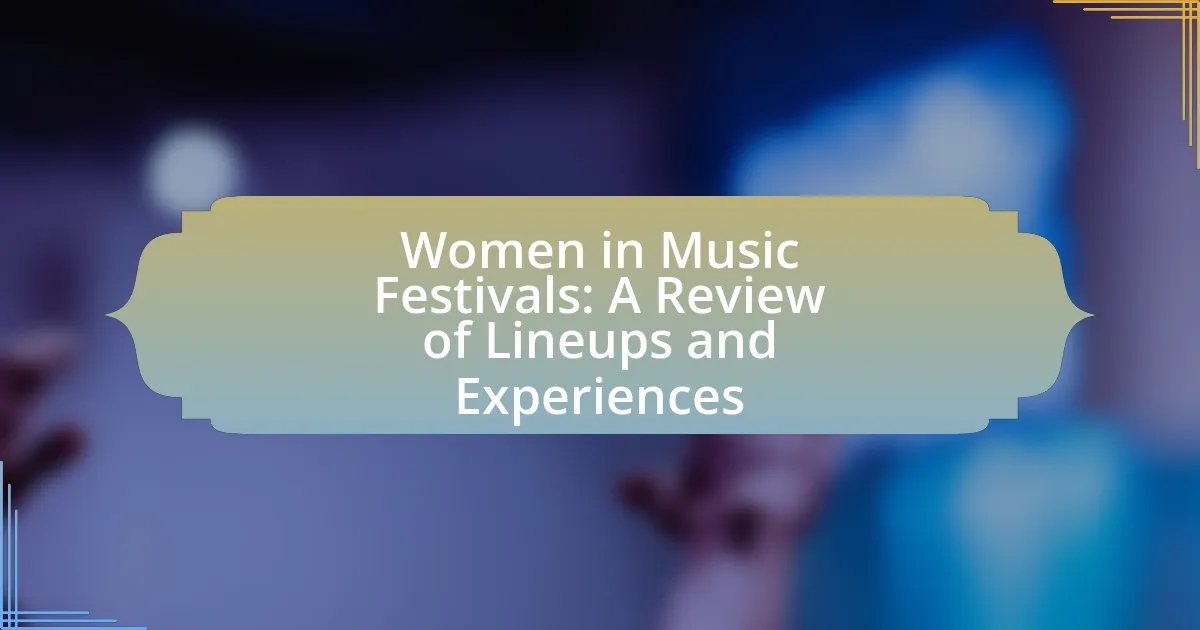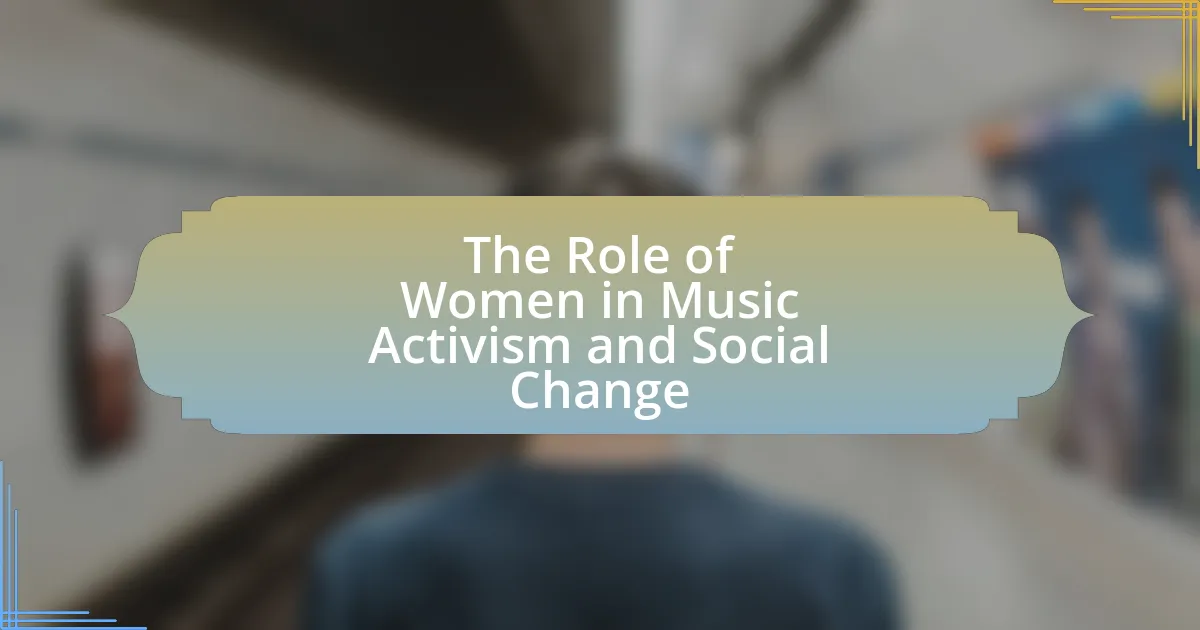The article examines the significant role of women in shaping indie music scenes, highlighting their contributions as artists, producers, and promoters. It discusses the historical influence of female musicians, key movements like the Riot Grrrl movement, and the impact of female-led initiatives on the genre’s evolution. The article also addresses the challenges women face in the industry, including gender bias and underrepresentation, while showcasing how female perspectives enrich the creative process and themes in indie music. Current trends indicate an increase in visibility and participation of women in the indie genre, emphasizing the need for continued support and initiatives to promote gender equality within the music scene.
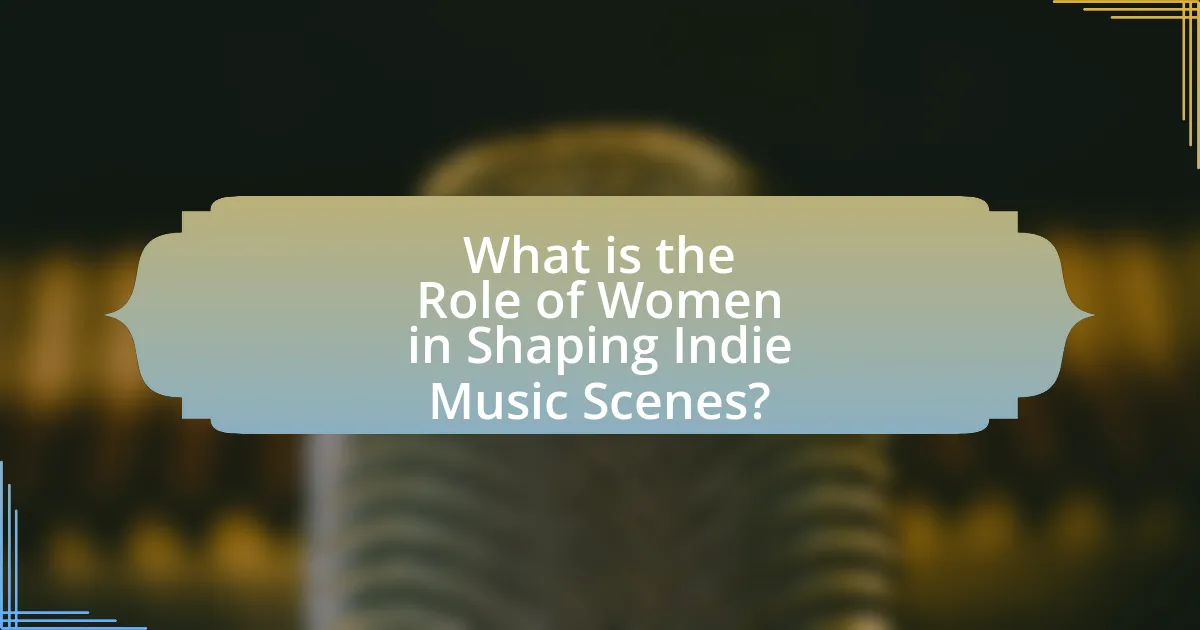
What is the Role of Women in Shaping Indie Music Scenes?
Women play a crucial role in shaping indie music scenes by contributing as artists, producers, and promoters, thereby influencing the genre’s sound and culture. Their involvement has led to the emergence of diverse musical styles and narratives, as seen in the rise of female-led bands and solo acts like Sleater-Kinney and Fiona Apple, who have challenged traditional norms and expanded the indie music landscape. Additionally, women have been instrumental in creating inclusive spaces within the indie scene, fostering community and collaboration, which has been documented in studies highlighting the impact of female musicians on audience engagement and genre evolution.
How have women historically influenced indie music scenes?
Women have historically influenced indie music scenes by serving as key artists, producers, and promoters who shaped the genre’s sound and culture. Notable figures such as Kim Deal of the Pixies and Liz Phair emerged in the 1990s, challenging gender norms and bringing diverse perspectives to songwriting and performance. Their contributions not only expanded the musical landscape but also inspired subsequent generations of female musicians, leading to a more inclusive and varied indie music scene. Additionally, women have played crucial roles in independent labels and music festivals, further solidifying their impact on the industry.
What key movements or events highlight women’s contributions to indie music?
Key movements that highlight women’s contributions to indie music include the Riot Grrrl movement of the early 1990s, which emphasized feminist punk rock and empowered women musicians, and the emergence of female-led indie labels such as Kill Rock Stars and 4AD, which provided platforms for women artists. The Riot Grrrl movement, characterized by bands like Bikini Kill and Sleater-Kinney, not only challenged gender norms but also inspired a generation of female musicians to express their experiences and perspectives. Additionally, the rise of artists like Fiona Apple and Liz Phair in the 1990s showcased women’s songwriting prowess and commercial viability in the indie scene, further solidifying their impact. These movements and events collectively illustrate the significant role women have played in shaping the indie music landscape.
How have female artists changed the perception of indie music?
Female artists have significantly changed the perception of indie music by introducing diverse narratives and breaking genre boundaries. Their presence has challenged traditional gender roles within the music industry, leading to a broader acceptance of varied musical styles and themes. For instance, artists like Phoebe Bridgers and Mitski have gained critical acclaim, showcasing introspective songwriting that resonates with a wide audience, thus elevating the indie genre’s emotional depth. Additionally, statistics from the 2021 Music Industry Report indicate that female artists accounted for 50% of the top indie music charts, highlighting their influence and the shift in audience perception towards inclusivity and representation in indie music.
What are the challenges faced by women in indie music?
Women in indie music face several challenges, including gender bias, lack of representation, and limited access to industry resources. Gender bias manifests in the form of stereotypes that question women’s musical abilities and leadership roles, often leading to fewer opportunities for women to perform or be recognized. According to a 2020 study by the Annenberg Inclusion Initiative, women made up only 22.5% of artists in popular music, highlighting the significant underrepresentation in the industry. Additionally, women often encounter barriers in networking and mentorship, which are crucial for career advancement in the music scene. These challenges collectively hinder the growth and visibility of women in indie music, impacting their ability to shape the genre effectively.
What barriers do women encounter in the indie music industry?
Women encounter several barriers in the indie music industry, including gender bias, lack of representation, and limited access to resources. Gender bias manifests in the form of stereotypes that question women’s musical abilities and leadership roles, often leading to fewer opportunities for women to perform or be taken seriously as artists. A study by the USC Annenberg Inclusion Initiative found that only 22.5% of artists in popular music are women, highlighting the significant underrepresentation in the industry. Additionally, women often face challenges in securing funding and support for their projects, as funding bodies and industry gatekeepers tend to favor male-led initiatives. This combination of bias, underrepresentation, and resource limitations creates a challenging environment for women in the indie music scene.
How do societal expectations impact women’s roles in indie music?
Societal expectations significantly impact women’s roles in indie music by often limiting their creative expression and professional opportunities. These expectations can manifest as stereotypes that suggest women should conform to specific genres or roles, such as being vocalists rather than instrumentalists or songwriters. For instance, a study published in the Journal of Popular Music Studies found that female musicians frequently face biases that question their technical abilities and authenticity, which can hinder their participation in the indie music scene. Additionally, societal norms may pressure women to balance music careers with traditional roles, affecting their visibility and influence within the industry.
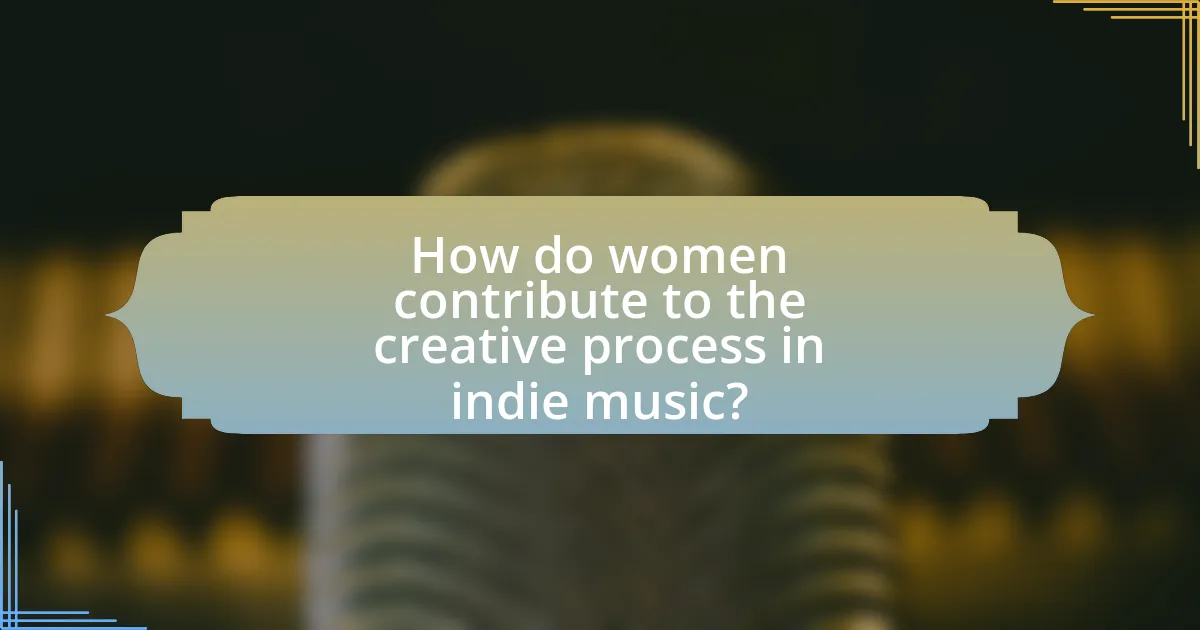
How do women contribute to the creative process in indie music?
Women contribute to the creative process in indie music by bringing diverse perspectives, innovative songwriting, and unique artistic expressions. Their involvement often leads to the exploration of themes such as identity, empowerment, and social issues, which resonate with a broad audience. For instance, artists like Phoebe Bridgers and Mitski have gained recognition for their introspective lyrics and emotional depth, influencing the indie music landscape significantly. Research indicates that female musicians often collaborate with one another, fostering a supportive community that enhances creativity and visibility within the genre. This collaborative spirit is evident in various indie music festivals and collectives that prioritize female representation, further solidifying their impact on the creative process.
What roles do women play in songwriting and production?
Women play significant roles in songwriting and production, contributing as songwriters, producers, and collaborators in the music industry. Their involvement has led to diverse musical expressions and innovative sounds, shaping the indie music scene. For instance, women like Fiona Apple and Billie Eilish have not only written their own songs but also taken on production roles, influencing the creative direction of their music. According to a 2021 report by the Annenberg Inclusion Initiative, women accounted for 12.6% of songwriters and 2.1% of producers in popular music, highlighting the ongoing need for greater representation. This data underscores the importance of women’s contributions and the potential for increased visibility and impact in the industry.
How do female perspectives shape the themes in indie music?
Female perspectives significantly shape the themes in indie music by introducing diverse narratives and emotional depth that reflect women’s experiences. This influence is evident in the exploration of topics such as identity, relationships, and societal issues, often challenging traditional gender roles. For instance, artists like Phoebe Bridgers and Mitski have garnered critical acclaim for their introspective lyrics that address mental health and personal struggles, resonating with a wide audience. Research indicates that female artists in indie music often prioritize authenticity and vulnerability, which can lead to a more nuanced portrayal of themes compared to their male counterparts. This shift not only enriches the genre but also fosters a more inclusive music scene that encourages varied expressions of femininity and personal storytelling.
What impact do women have on the sound and style of indie music?
Women significantly influence the sound and style of indie music by introducing diverse perspectives and innovative approaches to songwriting and performance. Their contributions often lead to the exploration of themes such as identity, empowerment, and emotional vulnerability, which resonate deeply with audiences. For instance, artists like Fiona Apple and St. Vincent have redefined genre boundaries, blending elements of rock, pop, and experimental music, thereby expanding the sonic landscape of indie music. Additionally, studies indicate that female musicians often prioritize collaboration and community, fostering inclusive environments that encourage creativity and experimentation. This collaborative spirit has been instrumental in shaping the indie music scene, as seen in collectives like Girlpool and the rise of female-led bands.
How do women support each other within indie music scenes?
Women support each other within indie music scenes through collaboration, mentorship, and community-building initiatives. Collaborative projects, such as co-writing songs or forming all-female bands, foster a sense of solidarity and shared creativity. Mentorship programs, where experienced female musicians guide emerging artists, help to navigate the challenges of the industry. Additionally, women often create inclusive spaces, such as female-focused music festivals and workshops, which promote networking and visibility. Research indicates that these supportive networks can lead to increased opportunities and representation for women in music, as seen in initiatives like the “Girls Rock!” camps, which empower young female musicians through education and performance opportunities.
What initiatives or organizations exist to empower women in indie music?
Organizations that empower women in indie music include Girls Rock Camp, which provides music education and mentorship to young girls, and She Shreds Magazine, focused on female guitarists and musicians. Additionally, the organization Women in Music advocates for gender equality in the music industry through networking and educational opportunities. These initiatives are crucial as they address the gender disparity in music, with studies indicating that women make up only about 20% of artists in the industry.
How do collaborations among female artists enhance the indie music landscape?
Collaborations among female artists enhance the indie music landscape by fostering creativity, diversity, and community. These partnerships often lead to innovative soundscapes that challenge traditional genre boundaries, as seen in projects like the supergroup Boygenius, which combines the talents of Phoebe Bridgers, Lucy Dacus, and Julien Baker. Such collaborations not only amplify individual voices but also create a supportive network that encourages emerging artists. Research indicates that female collaborations in music can lead to increased visibility and representation, as highlighted by the 2020 report from the Annenberg Inclusion Initiative, which found that female artists are significantly underrepresented in the music industry. By working together, female artists can collectively address these disparities, ultimately enriching the indie music scene.
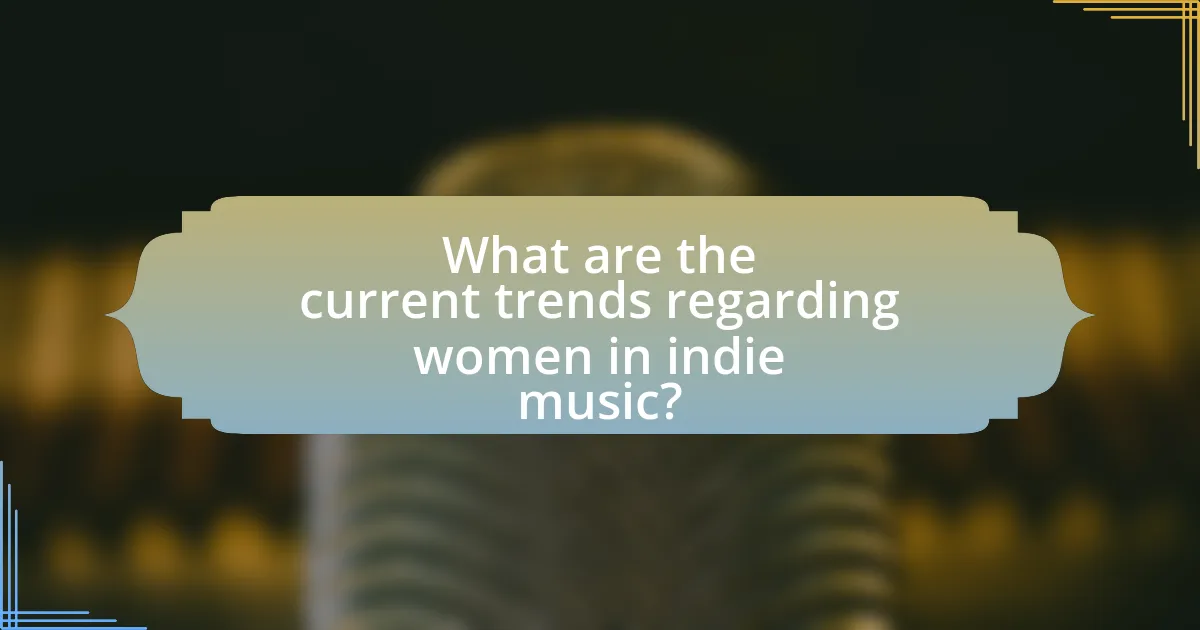
What are the current trends regarding women in indie music?
Current trends regarding women in indie music show a significant increase in visibility and influence, with more female artists leading projects and gaining recognition. According to a 2023 report by the Annenberg Inclusion Initiative, women comprised 40% of artists in the indie genre, a notable rise from previous years. Additionally, female-led bands and solo acts are increasingly dominating festival lineups, reflecting a shift towards greater gender parity in the music industry. This trend is supported by the success of artists like Phoebe Bridgers and Mitski, who have garnered critical acclaim and commercial success, further inspiring a new generation of female musicians.
How has the representation of women in indie music evolved in recent years?
The representation of women in indie music has significantly improved in recent years, with a notable increase in visibility and recognition. Data from the 2021 Music Industry Report indicated that women made up 40% of artists in the indie genre, a substantial rise from previous years. Additionally, festivals and platforms have increasingly prioritized female artists, with events like the 2022 Primavera Sound featuring a lineup that was 50% female. This shift reflects a broader cultural movement towards gender equality in the music industry, supported by initiatives aimed at promoting female talent and addressing historical disparities.
What statistics reflect women’s participation in indie music today?
Women’s participation in indie music today is reflected in statistics showing that approximately 30% of artists in the genre are women. This figure highlights a significant presence, although it remains below parity. Additionally, a 2022 report from the Annenberg Inclusion Initiative indicated that only 22% of songs on popular indie playlists featured female artists, suggesting ongoing gender disparities in visibility and representation. Furthermore, research by the Music Industry Research Association found that women comprise about 25% of music producers in the indie scene, indicating a need for greater inclusion in behind-the-scenes roles. These statistics collectively illustrate both the progress and challenges women face in the indie music landscape.
How are social media and technology influencing women’s roles in indie music?
Social media and technology are significantly empowering women in indie music by providing platforms for self-promotion, collaboration, and community building. Women artists can now share their music directly with audiences through platforms like Instagram, Bandcamp, and SoundCloud, bypassing traditional gatekeepers such as record labels. This direct access has led to increased visibility and opportunities for female musicians, as evidenced by the rise of successful indie female artists who have gained substantial followings online. Additionally, technology facilitates collaboration across geographical boundaries, allowing women to connect and create music together regardless of location, further diversifying the indie music scene.
What can be done to further support women in indie music?
To further support women in indie music, initiatives should focus on increasing visibility and access to resources. Establishing mentorship programs that connect emerging female artists with established musicians can provide guidance and industry insights. Additionally, promoting female-led music festivals and events can create platforms for women to showcase their talent, as evidenced by the success of festivals like Girls Rock Camp, which empowers young female musicians. Furthermore, increasing funding and grants specifically for women in music can help alleviate financial barriers, as studies show that women often face challenges in securing funding compared to their male counterparts.
What strategies can indie music scenes implement to promote gender equality?
Indie music scenes can implement strategies such as creating mentorship programs for women artists and ensuring diverse representation in lineups to promote gender equality. Mentorship programs can connect emerging female musicians with established artists, fostering skill development and networking opportunities, which is crucial given that women are underrepresented in music production roles, comprising only 2% of producers in the industry according to a 2020 report by the Annenberg Inclusion Initiative. Additionally, actively curating events that feature a balanced gender representation can challenge the status quo and encourage more women to participate in the indie music scene, as studies show that visibility leads to increased participation.
How can fans and listeners contribute to the visibility of women in indie music?
Fans and listeners can contribute to the visibility of women in indie music by actively promoting their work through social media, attending their shows, and supporting their music financially. By sharing music from female artists on platforms like Instagram and Twitter, fans amplify their reach and introduce these artists to new audiences. Additionally, attending live performances not only boosts ticket sales but also creates a supportive environment that encourages venues to book more female acts. Financial support through purchasing music, merchandise, or crowdfunding campaigns directly impacts the sustainability of these artists’ careers. Research indicates that increased visibility leads to greater opportunities for women in music, as highlighted in the 2021 report by the Annenberg Inclusion Initiative, which found that female artists receive significantly less airplay and media coverage compared to their male counterparts.
What are some best practices for aspiring female artists in indie music?
Aspiring female artists in indie music should focus on building a strong personal brand and network within the industry. Establishing a unique artistic identity helps differentiate them in a competitive market, while networking with other musicians, producers, and industry professionals can open doors to collaboration and opportunities. Research indicates that women in music who actively engage in networking are more likely to secure gigs and collaborations, enhancing their visibility and career prospects. Additionally, leveraging social media platforms effectively allows female artists to reach wider audiences and showcase their work, which is crucial in the indie music scene where self-promotion is often key to success.
